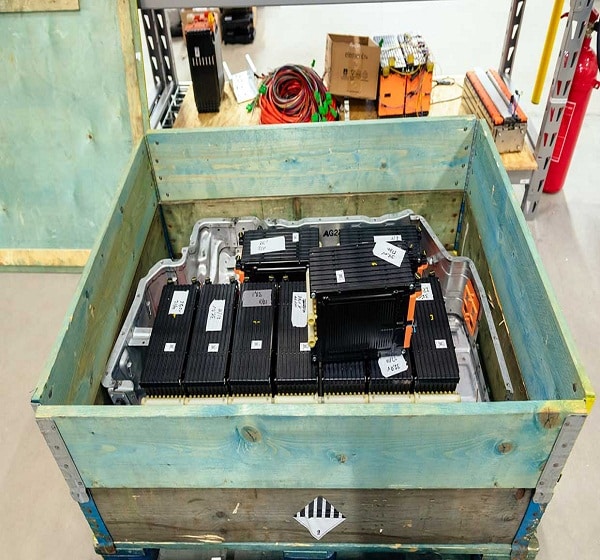As the number of electric vehicles on the world’s roads multiplies, a variety of used EV batteries will inevitably come into the marketplace. This, says a team of MIT researchers, could provide a golden opportunity for solar energy: Grid-scale renewable energy storage. This application, they find, can run efficiently on batteries that aren’t quite up to snuff for your Tesla or Chevy Bolt.
There are now two million solar energy installations in the United States alone. This number, according to Wood Mackenzie and the Solar Energy Industries Association, is expected to grow to three million next year and to four million by 2023. Yet such installations can only generate electrons when the sun is shining, which means plenty of solar power will be available during daytime hours, with a dearth of power on cloudy days or at night.
In other words, as solar (and wind) power expands, the need for energy storage only ramps up, says Ian Mathews, Marie Curie research fellow formerly at MIT (now at Tyndall National Institute in Cork, Ireland).
“As you increase the penetration of solar energy on the grid, you need to start to do something to deal with the fact that solar energy produces a lot during the middle of the day,” Mathews said. “But often you want to meet loads later in the day. And obviously lithium-ion batteries are getting a lot of attention in this area—and are being deployed quite widely.”
But lithium-ion batteries are also expensive. And, so long as rare minerals like cobalt are needed to make them, they’re also dependent on a limited and dwindling natural resource.
So Mathews and five co-researchers from the mechanical engineering department at MIT’s Sloan School of Management and from the cross-disciplinary MIT Energy Initiative modeled the economics of three storage scenarios over a grid-scale solar farm’s 20-year life cycle. The researchers looked at the revenues that such a farm would generate without storage, with a new lithium-ion battery bank, and with a battery bank built from used EV batteries operating at 80 percent capacity.
For batteries reduced to 80 percent of their original capacity, Mathews said, it’s reasonable to assume an EV owner will want better performance from their car—and will likely trade up. But grid storage doesn’t place such a high premium on extracting every last ounce of energy from every cell. For grid storage, 80 percent performance is good enough. Especially if that used battery comes to the solar farm at a good price.
The other assumption the researchers made, Mathews said, was that the battery storage would be used for time-shifting energy over the span of hours.
Ultimately, large solar installations will probably need multiple kinds of storage. Shorter-term storage like the used-battery banks his group studied may handle day-to-night needs, while longer-term storage can better mete out electrons over the course of cloudy or rainy days. Some ultra-long-term storage, he added, could even reserve extra amps during summer to dole out during winter’s shorter days.
“We chose one particular revenue stream—a solar plant with a battery that was connected to it that was able to charge up during the day and sell into the merchant power market during the evening,” Mathews said.
The group ultimately found that used EV batteries purchased at 80 percent of their original capacity will deliver marginally better revenues for the solar plant than a similar bank of new batteries. And if the solar farm can buy those batteries at 60 percent of original retail price, the farm can potentially even return a profit—all other factors being equal.
Mathews said EVs are still coming online in small enough numbers that their used battery packs haven’t yet become a big or noticeable force to reckon with. But he expects in a few years’ time, that will probably change. Used EV batteries could become so widely available that they’d be valuable for any number of energy storage applications.
And now that the group has discovered the parameters for viable solar energy storage, Mathews said he’s already in touch with some investors who are now getting set up in the “second-life battery” marketplace. (For instance, one California company, B2U Storage Solutions, announced last month the christening of a 1.2-megawatt-hour solar energy storage bank made from 2000 used Nissan Leaf batteries.)
In the near term, says Mathews, there may be more applications of second-life EV battery storage at the residential scale.
“Applications that require smaller final battery packs will be a better place to start,” he said.
This is because the infrastructure needed to hitch together many repurposed EV batteries—potentially involving batteries originating with any number of different manufacturers—has yet to be built.
One big challenge in that area, Mathews said, involves scaling up the scanning and sorting of second-life batteries. Some batteries might be better grouped together in one region of a given battery bank’s circuit. Other batteries that had been worn down enough might be rejected entirely. This sorting stage could also involve scanning a battery with ultrasound or other imaging technologies—or perhaps just running the right suite of voltage and current charging and discharging measurements.
The other challenge involves building an all-purpose, second-life battery management system. “There’s more work to be done in that area,” Mathews says. “It involves collaboration between people who have the data, people who can build the smart control algorithms, and the people who build the electronics around these systems.”
Spectrum










